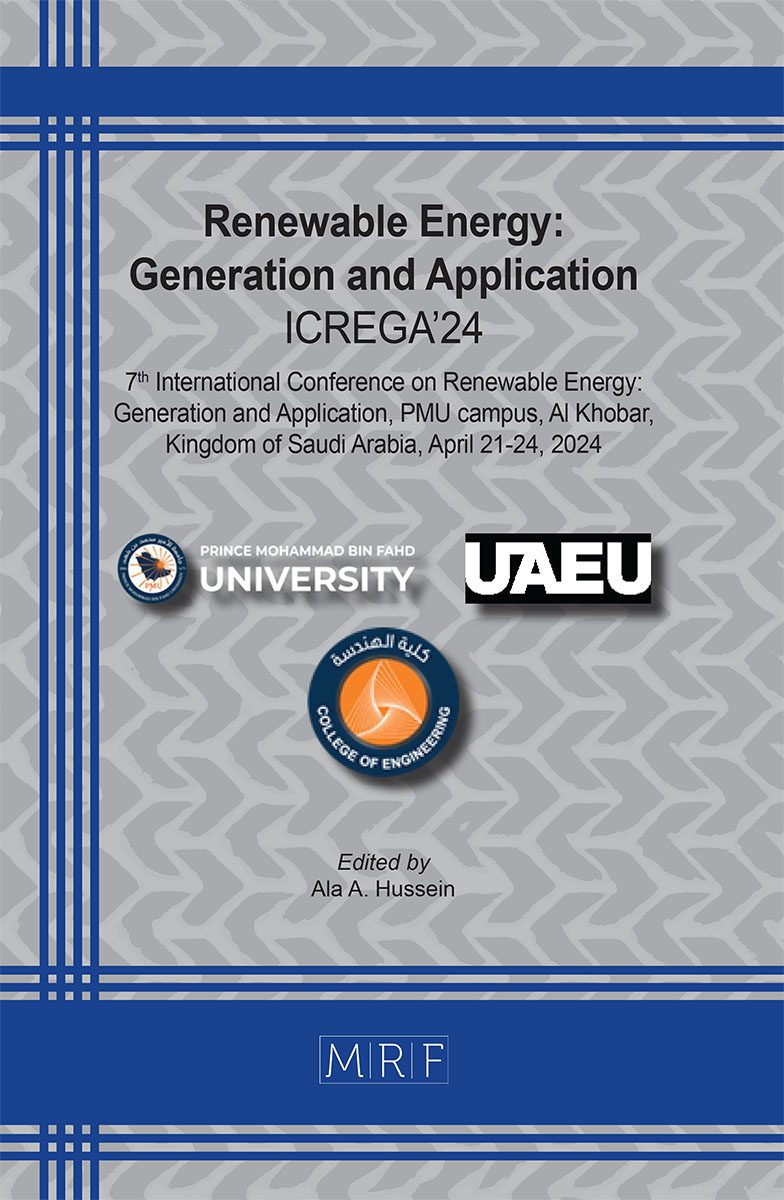–
Energy efficiency and sustainability enhancement of electric discharge machines by incorporating nano-graphite
Asaad A. ABBAS, Raed R. SHWAISH, Shukry H. AGHDEAB, Waleed AHMED
download PDFAbstract. The research paper endeavored to significantly improve the energy efficiency and sustainability of the electrode wear rate (EWR) in electric discharge machining (EDM) through a particular exploration of various parameters. These parameters included nano-powder concentration, electric current, and pulse-on time. By systematically analyzing and manipulating these variables, the study aimed to optimize the EDM process, thereby reducing energy consumption and enhancing the overall sustainability of the machining operation. We employed the Powder Mixed Electro-Discharge Machining (PMEDM) technique, a refined iteration of electric discharge machining. This innovative method blended graphite nano-powder with transformer oil to serve as the dielectric medium. The primary objective of this investigation is to examine the outcomes concerning crucial process parameters such as graphite powder concentration, electric current, and pulse-on time when machining high-speed steel, focusing mainly on electrode wear rate (EWR). Incorporating nano graphite (Gr) mixed powders into dielectric liquids has demonstrated a discernible enhancement in EWR across diverse operational conditions. The study found that the electrode wear rate (EWR) varied based on nano-powder concentration, electric current, and pulse-on time. Maximum EWR was observed at a concentration of 10 g/L, a current of 30 A, and a pulse-on time of 70 µs, while minimum EWR occurred at 0 g/L, 10 A, and 60 µs. The Full Factorial design, executed with MINITAB 17 software, validated these findings. The optimal EWR recorded was 1.154 mm3/min. The coefficient of determination (R-sq) for surface roughness prediction also stood at 91.15%.
Keywords
EDM, Nano-Powder Mixed Electro-Discharge Machining, Electrode Wear Rate, Full Factorial
Published online 7/15/2024, 8 pages
Copyright © 2024 by the author(s)
Published under license by Materials Research Forum LLC., Millersville PA, USA
Citation: Asaad A. ABBAS, Raed R. SHWAISH, Shukry H. AGHDEAB, Waleed AHMED, Energy efficiency and sustainability enhancement of electric discharge machines by incorporating nano-graphite, Materials Research Proceedings, Vol. 43, pp 124-131, 2024
DOI: https://doi.org/10.21741/9781644903216-17
The article was published as article 17 of the book Renewable Energy: Generation and Application
![]() Content from this work may be used under the terms of the Creative Commons Attribution 3.0 license. Any further distribution of this work must maintain attribution to the author(s) and the title of the work, journal citation and DOI.
Content from this work may be used under the terms of the Creative Commons Attribution 3.0 license. Any further distribution of this work must maintain attribution to the author(s) and the title of the work, journal citation and DOI.
References
[1] Y. H. Guu, H. Hocheng C. Y. Chou and C. S. Deng, “Effect of electrical discharge machining on surface characteristics and machining damage of AISI D2 tool steel”, Materials Science and Engineering, A 358, pp. 37-43, 2003. https://doi.org/10.1016/S0921-5093(03)00272-7
[2] Sundaram M. M. and K. Rajurkar, “Electrical and Electrochemical Processes, in Intelligent Energy Field Manufacturing”, CRC Press. p. 173-212, 201, 2011. https://doi.org/10.1201/EBK1420071016-c6
[3] Klocke F., Zeis M., Klink A. and Veselova D., “Technological and Economical Comparison of Roughing Strategies via Milling, EDM and ECM for Titanium- and Niclelbased Blisks”, Proceedings of the 1st CIRP Global Web Conference on Interdisciplinary Research in Production Engineering, Vol. 2, pp. 98-101, 2012. https://doi.org/10.1016/j.procir.2012.05.048
[4] Gu L., Le. L., Zhao W., and Rajurkar K. P., “Electrical Discharge Machining of Ti6Al4V with Bundled Electrode”, International Journal of Machine Tools and Manufacturing, Vol. 53, pp. 100- 106, 2012. https://doi.org/10.1016/j.ijmachtools.2011.10.002
[5] Jahan M., Malshe A. and Rajurkar K., “Experimental Investigation and Characterization of Nano-scale Dry Electro-machining”, Journal of Manufacturing Processes, Vol. 14 pp. 443-451, 2012. https://doi.org/10.1016/j.jmapro.2012.08.004
[6] Klocke F., “EDM Machining Capabilities of Magnesium (Mg) Alloy WE43 for Medical Applications”, Procedia Engineering, Vol. 19(0): pp. 190-195, 2011. https://doi.org/10.1016/j.proeng.2011.11.100
[7] H. Singh, “Experimental study of distribution of energy during EDM process for utilization in thermal models”, International Journal of Heat and Mass Transfer, 2012. https://doi.org/10.1016/j.ijheatmasstransfer.2012.05.004
[8] Ahmed N. Al-Khazraji, Samir A. Al-Rabii and Ali H. Al-Jelehawy,” Fe Analysis of Residual Stresses Induced by Spot Welding of Stainless-Steel Type AISI 316″ Engineering and Technology Journal, Vol. 32, Part (A), No. 2, 2014. https://doi.org/10.30684/etj.32.2A.7
[9] Ahmed N. Al-Khazraji, Farag M. Mohammed and Ali Riyadh A. Al-Taie,” Residual Stress Effect on Fatigue Behavior of 2024- Aluminum Alloy” Engineering and Technology Journal, Vol. 29, No. 3, 2011. https://doi.org/10.30684/etj.29.3.13
[10] Ahmed N. Al-Khazraji, Samir A. Al-Rabii and Ali H. Fahem,” Formation of Compressive Residual Stresses by Shot Peening for SpotWelded Stainless Steel Plates” Engineering and Technology Journal, Vol. 31, Part (A), No. 11, 2013. https://doi.org/10.30684/etj.31.11A14
[11] Wang, C. H., Lin, Y. C., Yan, B. H. and Huang, F. Y., “Effect of characteristics of added powder on electric discharge machining”, J. Jpn. Inst. Light Met., Vol. 42 (12), pp. 2597–2604, 2001. https://doi.org/10.2320/matertrans.42.2597
[12] Tzeng, Y. F., Lee, C. Y., “Effects of powder characteristics on electro-discharge machining efficiency”, Int. J. Adv. Manuf. Technol., Vol. 17, pp. 586–592, 2001. https://doi.org/10.1007/s001700170142
[13] C. Huang, J. Wang and X. Li, “Powder Mixed near Dry Electrical Discharge Machining”, Advanced Materials Research, Vol. 500, 2012. https://doi.org/10.4028/www.scientific.net/AMR.500.253
[14] N. S. Khundrakpam, H. Singh, S. Kumar, and G. S. Brar,” Investigation and Modeling of Silicon Powder Mixed EDM using Response Surface Method”, International Journal of Current Engineering and Technology, Vol.4, No.2 (April 2014).
[15] B. Reddy, G.N. Kumar, and K. Chandrashekar, “Experimental Investigation on Process Performance of Powder Mixed Electric Discharge Machining of AISI D3 steel and EN-31 steel”, International Journal of Current Engineering and Technology, Vol. 4, No. 3, June 2014.
[16] S. Assarzadeh and M. Ghoreishi, “A dual response surface-desirability approach to process modeling and optimization of Al2O3 powder-mixed electrical discharge machining (PMEDM) parameters,” The International Journal of Advanced Manufacturing Technology, Vol. 64, No. 9-12, pp. 1459-1477, 2013. https://doi.org/10.1007/s00170-012-4115-2












